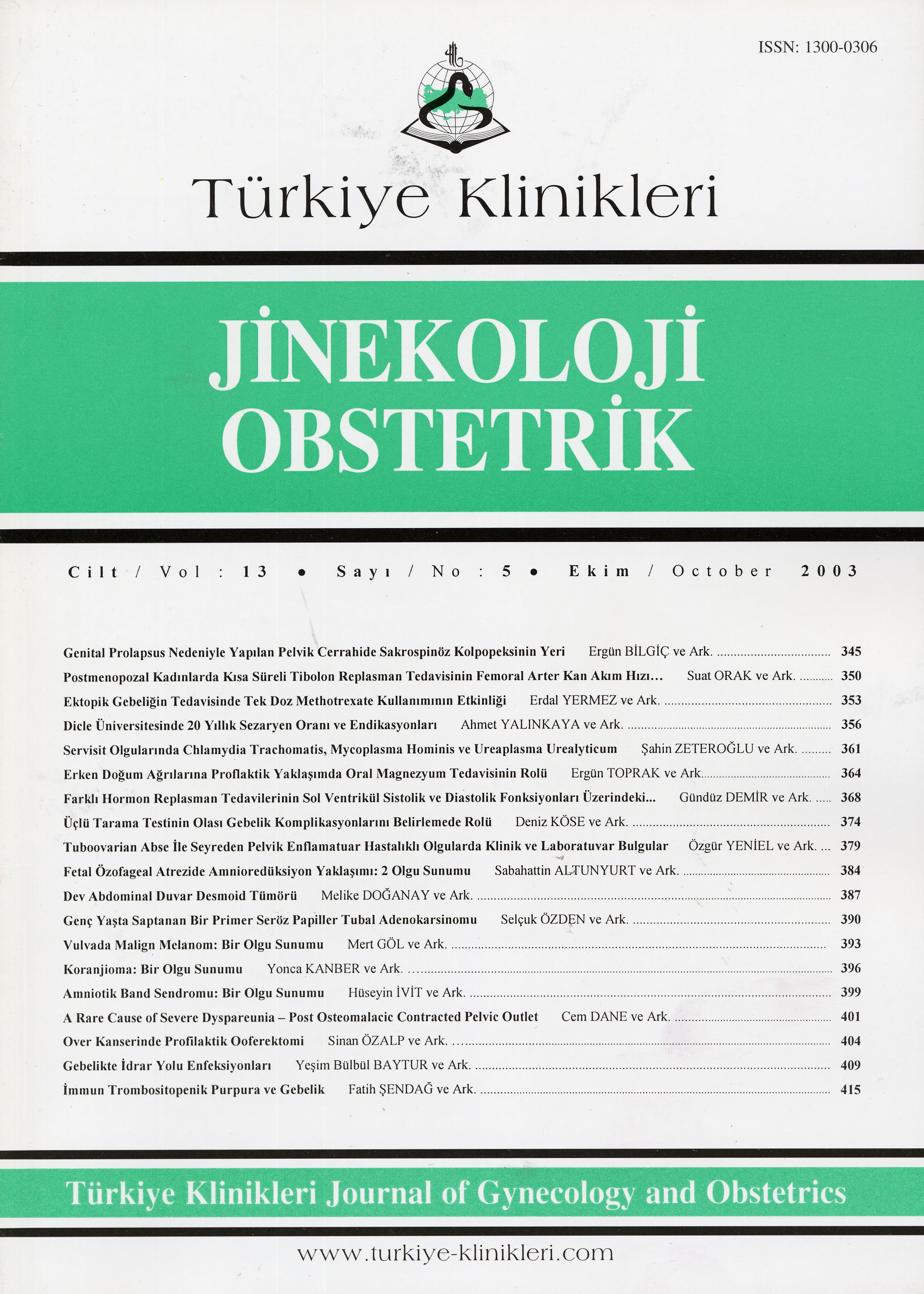Open Access
Peer Reviewed
ARTICLES
2553 Viewed919 Downloaded
Chorangioma: A Case Report
Koranjioma: Bir Olgu Sunumu
Turkiye Klinikleri J Gynecol Obst. 2003;13(5):396-8
Article Language: TR
Copyright Ⓒ 2020 by Türkiye Klinikleri. This is an open access article under the CC BY-NC-ND license (http://creativecommons.org/licenses/by-nc-nd/4.0/)
ÖZET
Amaç: Bir koranjiom olgusu sunmak. Çalışmanın Yapıldığı Yer: K.S.Ü. Eğitim ve Araştırma Hastanesi Olgu Sunumu: Rutin takipte olan 33 yaşında, G:2 P:1 olan gebe, eski sezaryen öyküsü nedeniyle gebeliğinin 37. haftasında opere edildi. Bebek ve annede herhangi bir soruna rastlanmadı. Plasentanın makroskopik incelemesinde marjinal yerleşimli, 4.5x3x2.5cm boyutlarında, kahverengi, solid yapıda, yer yer küçük kistik boşluklar içeren bir kitle saptandı. Histolojik incelemede farklı çaplarda damar proliferasyonundan oluşan bir lezyon mevcuttu. Sonuç: Koranjiomlar plasentanın en sık görülen benign tümörleridir. Plasentalar dilimlenmeden incelendiğinde bu tümörler kolaylıkla atlanabilmektedir. Küçük çaplı koranjiomlar bir sorun çıkarmazken, büyük çaplarda olduklarında hem anne hem de bebekte çeşitli komplikasyonlara yol açabilmektedirler.
Amaç: Bir koranjiom olgusu sunmak. Çalışmanın Yapıldığı Yer: K.S.Ü. Eğitim ve Araştırma Hastanesi Olgu Sunumu: Rutin takipte olan 33 yaşında, G:2 P:1 olan gebe, eski sezaryen öyküsü nedeniyle gebeliğinin 37. haftasında opere edildi. Bebek ve annede herhangi bir soruna rastlanmadı. Plasentanın makroskopik incelemesinde marjinal yerleşimli, 4.5x3x2.5cm boyutlarında, kahverengi, solid yapıda, yer yer küçük kistik boşluklar içeren bir kitle saptandı. Histolojik incelemede farklı çaplarda damar proliferasyonundan oluşan bir lezyon mevcuttu. Sonuç: Koranjiomlar plasentanın en sık görülen benign tümörleridir. Plasentalar dilimlenmeden incelendiğinde bu tümörler kolaylıkla atlanabilmektedir. Küçük çaplı koranjiomlar bir sorun çıkarmazken, büyük çaplarda olduklarında hem anne hem de bebekte çeşitli komplikasyonlara yol açabilmektedirler.
ANAHTAR KELİMELER: Koranjioma (koryoanjiom), Plasenta
ABSTRACT
Objective: To present a case of chorangioma.Place of Study: K.S.Ü. HospitalCase Presentation: A 33 year old, G: 2 P: 1 pregnant woman at 37 weeks gestation had a cesarean section because of a previous cesarean section history. Neither the baby, nor the mother had any problems. On the gross examination of the placenta, a marginally located brown mass of 4.5x3x2.5cm was observed. On cut section the mass was solid and had small cystic cavities. Histological sections showed a proliferation of vessels of different diameters. Conclusion: Chorangiomas are the most frequent benign tumors of the placenta. They may be missed if the placentas are not bread-loafed on gross examination. Chorangiomas of small sizes may not have any clinical significance, but when they reach larger sizes complications may be seen in both the mother and the baby.
Objective: To present a case of chorangioma.Place of Study: K.S.Ü. HospitalCase Presentation: A 33 year old, G: 2 P: 1 pregnant woman at 37 weeks gestation had a cesarean section because of a previous cesarean section history. Neither the baby, nor the mother had any problems. On the gross examination of the placenta, a marginally located brown mass of 4.5x3x2.5cm was observed. On cut section the mass was solid and had small cystic cavities. Histological sections showed a proliferation of vessels of different diameters. Conclusion: Chorangiomas are the most frequent benign tumors of the placenta. They may be missed if the placentas are not bread-loafed on gross examination. Chorangiomas of small sizes may not have any clinical significance, but when they reach larger sizes complications may be seen in both the mother and the baby.
MENU
POPULAR ARTICLES
MOST DOWNLOADED ARTICLES





This journal is licensed under a Creative Commons Attribution-NonCommercial-NoDerivatives 4.0 International License.











